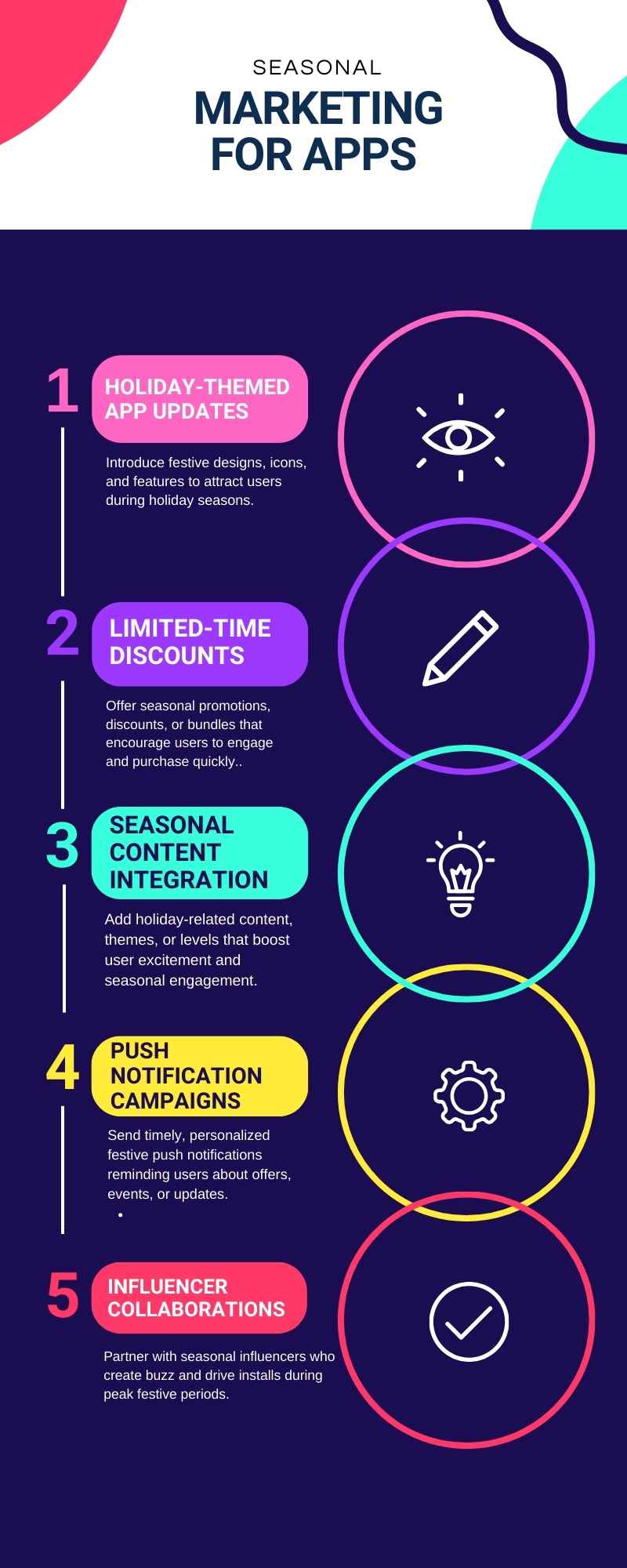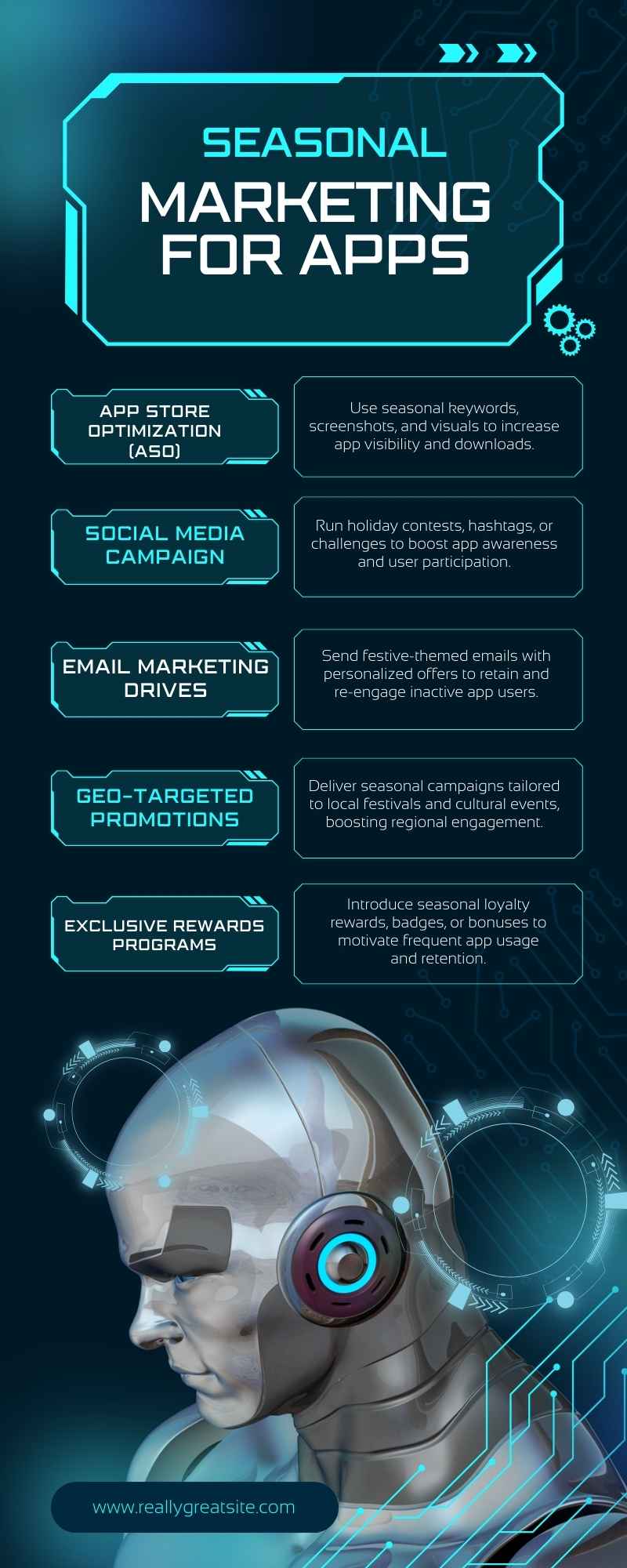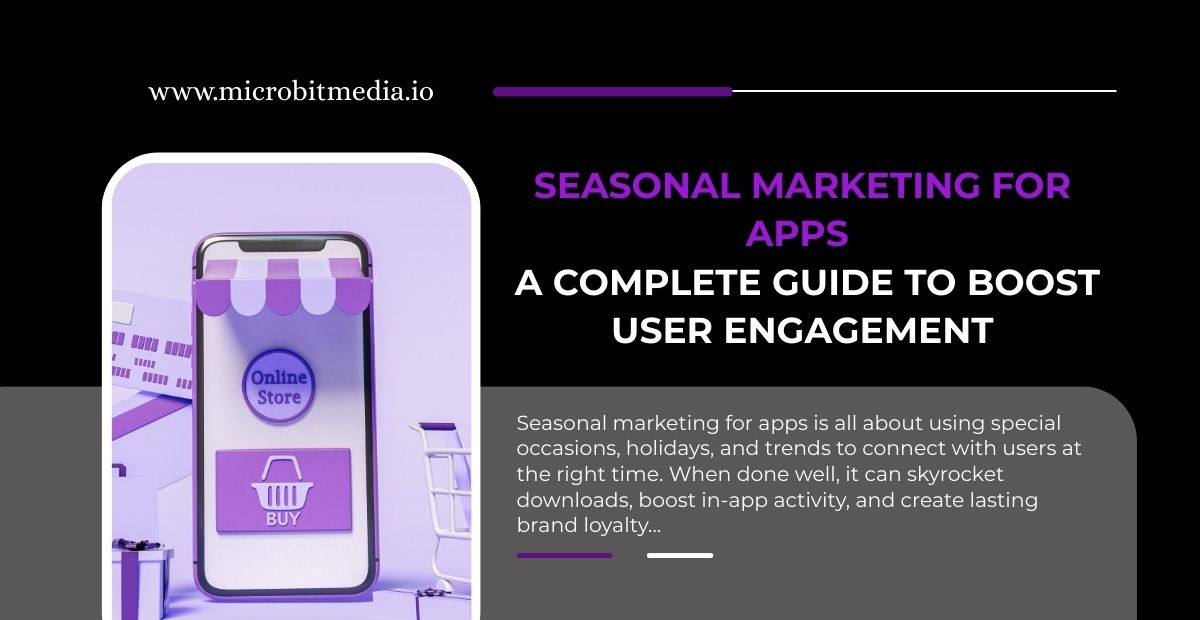Last updated on August 28th, 2025 at 04:36 am
Seasonal marketing for apps is all about using special occasions, holidays, and trends to connect with users at the right time. When done well, it can skyrocket downloads, boost in-app activity, and create lasting brand loyalty. From festive themes to limited-time offers, timing is everything in seasonal marketing for apps.
Key Takeaways:
- Refresh app visuals with seasonal designs for higher user appeal.
- Offer limited-time rewards to create urgency and engagement.
- Use seasonal push notifications to re-engage dormant users.
- Align campaigns with local and global events for broader reach.
- To increase activity, try exploring in-app challenges and operations.
- Plan early to stand out during peak competition seasons.
What is Seasonal Marketing for Apps?
Seasonal Marketing for Apps involves aligning your app’s promotions, visuals, and features with specific times of the year to attract more users and boost engagement. It’s a focused approach that uses events, holidays, and seasonal trends to create campaigns that feel timely and relevant.Here’s a clear breakdown:
- Definition and Core Idea: Seasonal Marketing for Apps means tailoring your marketing strategies to match periods when users are more likely to engage. It could be during holidays like Christmas, Diwali, or New Year, or during events such as the Cricket World Cup or summer sales season.
- Making Your App Relevant: People’s needs and moods change throughout the year. A food delivery app might see a spike during festival seasons, while a fitness app might see growth in January when health resolutions are high. Seasonal Marketing for Apps taps into these moments to make your app feel in tune with what users want right now.
- Visual and Functional Changes: Seasonal marketing isn’t just about running ads. It could involve introducing time-limited features, providing seasonal discounts, or affecting the app’s layout with festive themes. For example, a gaming app can introduce exceptional holiday levels, while an e-commerce app can feature gift bundles for Valentine’s Day.
- Driving Emotional Connection: When you tailor your app experience to a specific season, you connect with users on an emotional level.Your audience is more inclined to interact, share, and return if they see your app engaging in on their celebration. Seasonal Marketing for Apps works best when it combines practical value with emotional appeal.
- Boosting Installs and Retention: Timely campaigns encourage both new downloads and higher retention. A well-executed seasonal push notification or in-app reward can bring back users who haven’t opened your app in months.
- Why It’s More Than Just Sales: Seasonal Marketing for Apps is not only about promotions. It’s about showing users that your app is alive, responsive, and part of their lifestyle, no matter the season.
Why Seasonal Marketing is Important for App Growth
- Boosts visibility when competition is high: Seasonal Marketing for Apps helps your product stand out during festive or high-demand periods. When every brand is fighting for attention, a timely campaign gives your app an edge.
- Drives higher downloads and installs: Users are more active during seasonal peaks.Targeting these windows can multiply your installs.
- Increases in in-app purchases and revenue: People are more willing to spend during special occasions. Offering discounts, festive bundles, or limited-time features can directly improve your app’s earnings.
- Builds a stronger emotional connection: Seasonal Marketing for Apps connects with users on an emotional level.
- Encourages user re-engagement: Seasonal updates, themed visuals, and special rewards bring back inactive users. It keeps your app fresh and exciting throughout the year.
- Supports long-term brand loyalty: Consistent seasonal campaigns show that your app evolves with your users’ lifestyles. It can turn casual users into loyal advocates over time.

Finding the Best Seasonal Opportunities
- Study your audience’s calendar – Know which holidays, festivals, or events they celebrate most.
- Look beyond global holidays – Regional festivals can unlock untapped engagement potential..
- Analyze past performance – Identify which seasons previously drove higher installs or revenue.
- Sync campaigns with trends – Tie your app’s theme to popular seasonal hashtags or challenges.
- Stay flexible – Seasonal Marketing for Apps works best when you adapt quickly to emerging events.
Seasonal Marketing Strategies for Mobile Apps
Seasonal Marketing for Apps is all about aligning your app’s content, design, and promotions with events, holidays, and trends that matter to your audience. When done right, it can spark excitement, drive installs, and keep users coming back. The key is to blend creativity with timing so your app feels relevant in the moment.
- Update Your App’s Look and Feel: Visual changes instantly tell users something special is happening. Update icons, splash screens, and banners to reflect seasonal vibes. For example, a fitness app can add festive workout challenges during New Year’s resolution season, or a food delivery app can showcase themed menus during Christmas.
- Launch Limited-Time In-App Events: People love exclusivity. Introducing seasonal challenges, leaderboards, or rewards can boost engagement. Gaming apps often do this during Halloween or summer holidays, offering special characters or skins that disappear after the event ends.
- Personalize Push Notifications: Seasonal push notifications grab attention when they’re timely and relevant. For example, an e-commerce app might send “Your Diwali deals are waiting!” rather than a plain discount alert.
- Use Social Media Buzz: Social platforms are where seasonal trends explode. Pair your in-app promotions with social campaigns, influencer shoutouts, or short videos that match the season’s theme. It creates a loop between discovery and app engagement.
- Offer Seasonal Discounts and Bundles: A limited-time offer tied to a holiday or event can push hesitant users to make a purchase. For example, a language learning app might offer a discounted subscription during back-to-school season.
Pros and Cons of Seasonal Marketing for Apps
| Pros | Cons |
| Increases app downloads during peak periods | Can cause spikes followed by drops if not sustained |
| Boosts user engagement with fresh, timely content | Requires frequent updates to app visuals and features |
| Creates opportunities for special offers and in-app sales | May demand extra design, development, and marketing resources |
| Helps your app stay relevant in competitive markets | Risk of blending in if seasonal campaigns are generic |
| Encourages social sharing and word-of-mouth | Overuse may make seasonal changes feel forced |

Measuring Seasonal Marketing Success
Case Study 1: E-Commerce App During Diwali
An Indian e-commerce app launched a Seasonal Marketing for Apps campaign around Diwali. They introduced festive discounts, push notifications with cultural themes, and exclusive app-only deals. To measure success, they tracked install-to-purchase conversion rates and average order value during the festive season. Compared to the previous quarter, installs rose by 35%, but the real victory was the 50% jump in repeat purchases within two weeks. The insight? Tracking repeat usage gave a clearer picture of long-term value, not just installs.
Case Study 2: Fitness App During New Year Resolutions
A global fitness app timed its Seasonal Marketing for Apps campaign with New Year resolutions. They rolled out a “7-Day Free Trial” and gamified user streaks to capture health-conscious audiences. To measure effectiveness, they monitored daily active users (DAU), retention after 30 days, and premium upgrades. Results showed a 60% increase in DAU during January, but the more telling metric was that 40% of free-trial users converted to paid plans. This demonstrated how seasonal spikes, if tracked correctly, can lead to long-term subscriber growth.
Case Study 3: Travel App During Summer Holidays
A travel app targeted students and families with summer vacation campaigns. Their Seasonal Marketing for Apps strategy included location-based offers, app-exclusive hotel discounts, and partnerships with airlines. Success was measured using engagement metrics like session duration, in-app searches, and completed bookings. While installs rose by 25%, the standout metric was the 70% increase in completed bookings, proving that seasonal campaigns work best when tied directly to user intent. By mapping installs to actual bookings, the brand could clearly see ROI from its summer promotions.
Future Outlook for Seasonal Marketing for Apps
The future of Seasonal Marketing for Apps looks brighter than ever as brands increasingly align campaigns with festivals, holidays, and cultural events. With mobile users spending more time in apps during special occasions, businesses can leverage seasonal themes to drive higher installs, engagement, and revenue.
Emerging trends like AI-driven personalization, push notifications tailored to seasonal moods, and limited-time in-app offers will dominate the landscape. As competition grows, creativity and timing will be the keys to success. Companies that adapt seasonal strategies smartly will stay ahead, ensuring stronger connections with users and maximizing app growth year-round.


